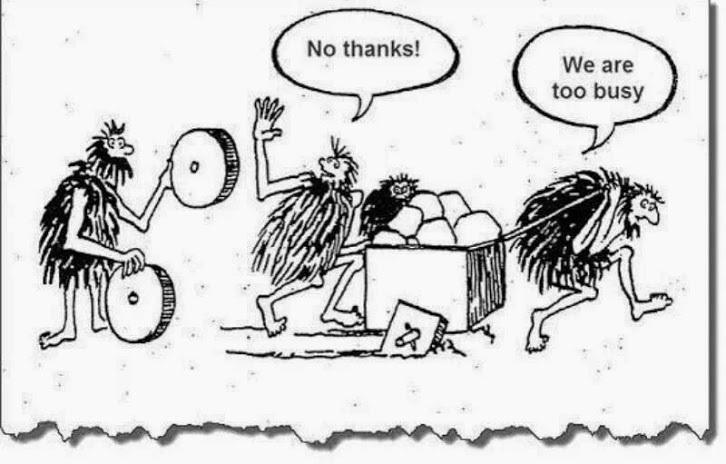Innovation? Sorry, we are busy
By: Hylke W. van Dijk
25 January 2019
A fun approach to wicked innovation

Innovation is a wicked and fun process. Wicked, since it is usually very difficult to plan and manage. And fun because making progress or mastering something new creates enjoyment. Unfortunately the focus is too often on the wicked part of innovation.
The comic below is an illustrative example by which innovation is frequently introduced. The comic, of unknown source, inspired Hakan Forss to use it in his lego ™ workshops on innovation. Scott Simmerman takes a similar approach in his square wheels ™ series of workshops.

People usually respond assentingly to the comic. They identify with the problem and appreciate the solution. Yet there are a few substantial problems with this comic. Let's do some digging.
First of all:
- Wheels are round and always have been round;
- Square wheels have been invented, but just recently for special purpose trajectories, which does not include mud though.
So we may question whether the comic does provide a true example of innovation, or does it merely demonstrate the reinvention of the wheel?
Practical innovation is more subtle and less radical. Presumably in practice one would redesign a round wheel into one that is more suitable for the situation. Let's say a wheel that has less weight or a wheel that is more sturdy. Or, if radical changes are permitted, not using wheels at all and use levitated carts or, possibly over the top, refrain from transporting stones all together.
Secondly:
- The offered innovation is an outsiders', knowing it all, view on the situation. Apparently we as viewers see an obvious solution and identify with the person who suggests this solution.
- The understanding of a problem from the inside is not further explored because of the apparent (possibly self inflicted) schedule of the workers.
Anthropologists discriminate between the emic and ethic understanding of a situation thus respectively taking an insiders' perspective and an outsiders' perspective. Bypassing the emic understanding disregards the necessary acceptance by the people involved, which typically yields resistance and revolt, rightly or wrongly. The ethic understanding, when imposed on an organisation may result in the infamous not invented here syndrome. People involved will require time to adhere to innovation.
Lastly, but most certainly not the least:
- Innovation is imposed with a solution;
- Innovation is considered a side project.
Bluntly starting from a solution is no gaurantee for success. In text books examples these silver bullet solutions are mere rhetoric constructs. In practice however solutions evolve over time rather than magically appear. Evolution takes time and requires nurturing. Hence, regarding innovation as something the apprentice can do on his own is an illusion.
In short, the comic captures an imaginary situation and suggests an unfavourable process. But it may trigger better contemplation.
Mastering Innovation
What if we regard innovation as an voluntary evolutionary process. Thus look at regard innovation as a process that never ends, that develops organically, and that has no other purpose than to weave opportunities into an established situation.
Typical phases of such an evolutionary innovation process include:
- Understanding the situation and opportunities
- Framing the vision
- Exploring the solution space
- Striding the path of vision
Beware this is neither a sequential nor a rigid process. Yet it is a fun process.
Understanding the situation and opportunities
If one abstracts from the real situation, one may ask what are the available values and mechanisms that can be used to transform a current situation?
Abstracting involves modelling and experimenting in a safe environment. By undertaking (playful) activities from which emic and ethic understandings emerge one creates affordance for contemplation, for combining emic and ethic understandings and for reifying abstract insights.
In other words, fitting time to play and to contemplate into your busy schedule.
Framing the vision
Given the actual situation, one may ask what is the desired situation?
Once we grasp a situation, we can frame and reframe the vision from our real life experience. The vision may include (modifications of) existing techniques or adopting new ones. The goal is thus to reiterate on a shared vision that merges business, technology, and social engineering.
Exploring the solution space
Given a shared vision, one may ask what are possible solutions to turn the vision into reality?
Working towards a desired situation, while enacting transformational mechanisms and values is a design process. Rapid prototyping, communication, and testing are essential ingredients for any successful design process. The process of exploring the solution space will reveal the value and feasibility of alternative solutions.
Striding the path of vision
Given a broad sense of solutions, one may ask what is a first step to success?
Attainability and acceptability are two of the many -ilities that define successful implementations of innovation. Given the organic process we propose, it will take one step at a time. Often little steps, and occasionally a larger step.
Remember, this is not the end but the trajectory. The modified situation that emerges from any stride will be (slightly) different from the anticipated one. New analysis, experiments, and design will be fun and insightful for selecting a next stride .
Returning to our starting point to regard innovation as an voluntary evolutionary process. Innovation is thus everywhere and always, often striding with seemingly tiny modification like mutational evolution and occasionally deploying some radical inventions like symbiogenesis evolution.
Closing remarks
The voluntary evolutionary approach to innovation and its implementations coincides with the general observation that
- Radical innovation almost never occurs in a running organisation; Management requires a sense of control and a radical change of affairs is a risky and costly operation;
- Innovation typically starts at the boundaries of organisation units;
- Innovation needs nuturing, support, and acceptance.
Our approach is geared towards growth and mastering, in an organic manner. We actually exploit fun to master innovation. We persuade you to spent time on contemplating about the here and why and glimpse into the future, without jeopardising your busy schedule. Such an attitude towards innovation is something you have to learn and in hindsight usually is not very involved. It requires guts though, because planning innovation meticulously is impossible.
By the way, you cannot win this game, since, following Stephen Jay Gould, evolution has no inherent drive towards long-term progress. But it helps you to survive and to enjoy.
Thanks to Hakan Forrs and Scott Simmerman for sharing the too busy to improve comic. It yields a nice trigger, but not in the straightforward sense.
Curious? Remarks? Drop us a note.
Hylke W. van Dijk
h.w.vandijk@digade.com

This work is licensed under a Creative Commons Attribution-ShareAlike 4.0 International License.